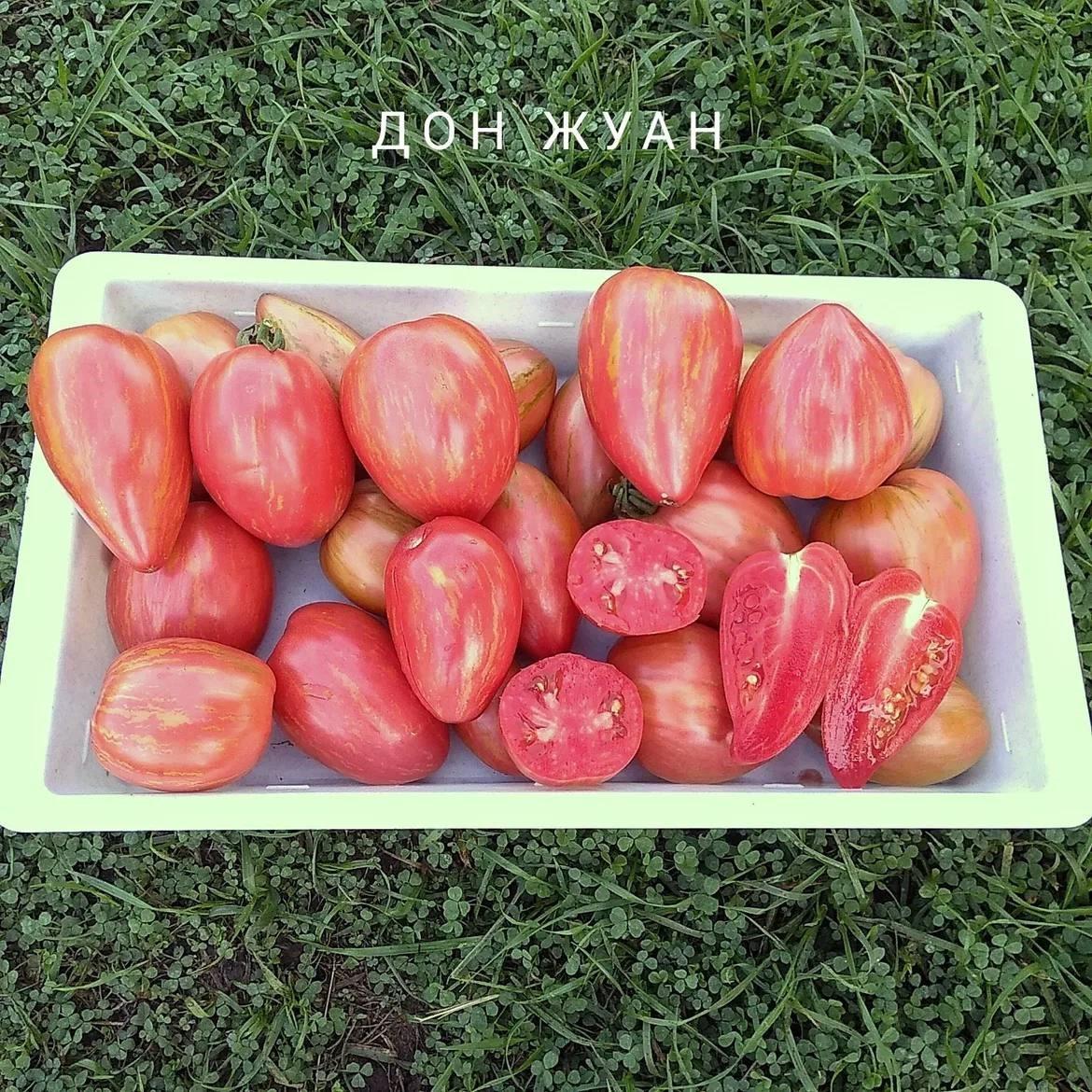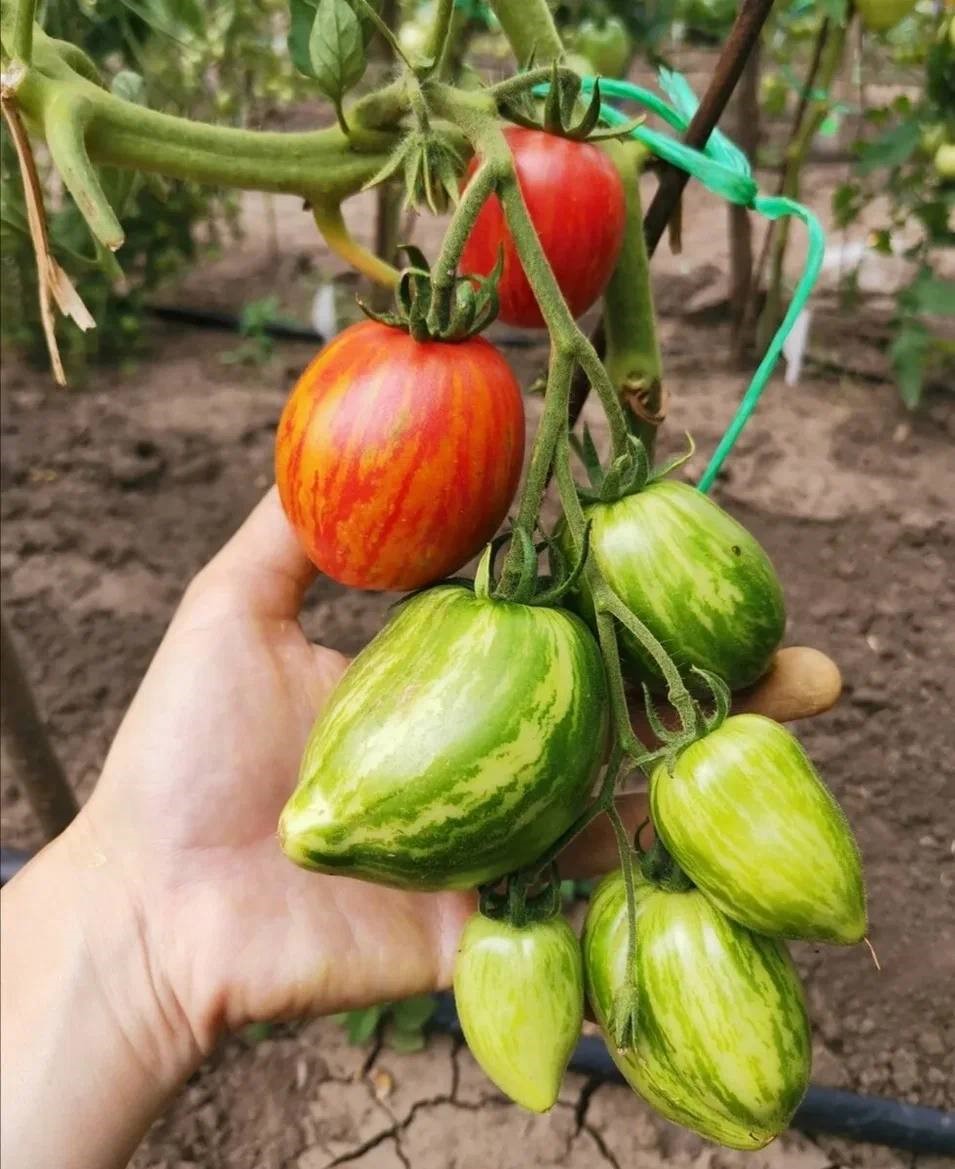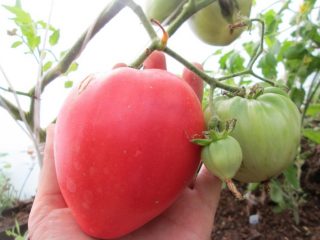Content
Thanks to the work of breeders, many original types of tomatoes were developed. One of the popular varieties is the Don Juan tomato. The plant requires little care and is easy to grow even for novice gardeners. You can familiarize yourself with the characteristics of the variety, planting and care features in this article.
History of selection

A variety of tomatoes resembles small watermelons in appearance
The Don Juan variety was bred by domestic breeders N. Novichkov, I. Shlyupikov and I. Shved. Work on the selection of the variety was carried out at the Agroterra Scientific and Technical Center in the 1990s. The variety is not included in the State Register of Breeding Achievements. Since the early 2000s, striped tomatoes have become popular throughout the CIS countries.
Description of the tomato variety Don Juan
Don Juan forms a tall bush with erect stems. The variety is resistant to drought, rain, and easy to care for. The tomatoes are large, smooth, with distinct stripes along their entire length. The taste is excellent.

The fruits on the bushes ripen together, they can be collected mechanically
Characteristics of the Don Juan tomato variety
The early ripening variety belongs to determinant crops. Before planting a variety, you should familiarize yourself with its characteristics:
- The bush has limited growth, the maximum height is 70 cm. The stems are powerful, thick, and develop well. The tops are spreading but compact, the branches are upright.
- The leaves are formed large, rich green in color, without a glossy sheen. On both sides of the leaf blade there is slight pubescence, median sections and veins. The edges of tomato leaves are inexpressively jagged. They can curl up due to drought or strong sunshine.
- The root system of the early ripening tomato variety Don Juan is taproot. When planted by seedlings, it develops mainly in the upper layers of the soil. When sowing seeds, the rhizome goes deep into the soil.
- The first inflorescences are formed at the height of the seventh leaf, further ones - every 1-2. The flowers are small, racemose, yellowish in color. Up to 4-5 tomatoes ripen on one bunch.
- The fruits are round, elliptical and slightly elongated with a barely noticeable protruding nose. The weight of one tomato is 70-80 g. The tomatoes are bright crimson with thin creamy streaks, and unripe specimens have dark green, thin stripes.
- The skin of tomatoes is smooth, but sometimes there is slight ribbing. It is dense, so the tomatoes do not crack. The pulp is juicy, fleshy, it contains 1-2 seed chambers with small seeds.
- Striped tomatoes have a rich taste that harmonizes with many other foods.The tomatoes are sweetish with a subtle sourness.
Tomatoes of Russian selection can be safely grown for sale, since their original appearance leaves no one indifferent.
Ripening and yield of Don Juan tomato
The early-ripening tomato variety is famous for its high level of fruiting. The fruits ripen 100-110 days after the appearance of the first shoots. This occurs in early to mid-July, depending on the climate in the growing region.
Taking into account the long fruiting period, about 5-8 kg of crop can be harvested from one bush, subject to proper care. Don Juan tomatoes growing in greenhouses bear fruit more abundantly. From one greenhouse bush it is usually possible to collect up to 10-12 kg of “strikes”.

To preserve tomatoes longer, it is recommended to pick them at the stage of technical maturity.
Resistance to diseases and pests
The determinate variety has high immunity, which allows it to resist diseases typical of the Solanaceae family and give a worthy rebuff to beetles. In the absence of proper care and improper growing conditions, Don Juan tomatoes lose their protective properties. Then the likelihood of developing diseases and pest attacks increases.
Growing regions
The Don Juan tomato variety can be grown in any region (except the Northern regions). These tomatoes prefer to grow in warm soil; even minor frosts are harmful to them. The crop is developing well and brings a lot of harvest in the middle zone and in the south.
Methods of application
Don Juan is a universal variety. Its fruits are used to prepare a variety of dishes. Striped tomatoes are great for sauces, salads, juices, and tomato puree.They can also be canned, used for pickling and drying. Striped tomatoes are used to make preparations for the winter.
Advantages and disadvantages
The determinate variety of tomatoes does not tolerate negative temperatures. Therefore, it is better for residents of the Northern regions to grow crops in greenhouses.

Tomatoes retain their shape well during heat treatment
Pros:
- pleasant taste of fruits, high content of vitamins and nutrients;
- attractive appearance of the fruit;
- versatility of crop application;
- excellent transportability;
- long shelf life;
- early ripening, which is important for areas with cold and short summers;
- high productivity;
- compact size of bushes;
- possibility of growing in open and closed ground;
- low maintenance requirements.
Minuses:
- low frost resistance.
Features of cultivation
It is recommended to start planting Don Juan tomato seedlings when the threat of return of night frosts has passed. This usually happens in mid-April. 2-3 weeks before planting, the area needs to be plowed with half a shovel to remove weeds. It is preferable to plant vegetables in well-lit areas where the wind does not blow. The ideal site would be the south or southwest side. On the day of planting the air temperature should be +20-25 degrees.
Work algorithm:
- The day before planting, holes are formed with a depth of 15 cm and a diameter of 15-20 cm. A distance of 60-80 cm is maintained between plants in a row and 80-100 cm between beds. The wells are watered generously with settled water at room temperature.
- Ammonium nitrate or nitroammophoska is poured onto the bottom to stimulate the growth of bushes and better adaptation.
- The seedlings are carefully placed in the holes, having first straightened the root system to the height of the first true leaves.
- The rhizome is sprinkled with soil, and the root zone is lightly compacted with your hands.
- The planted bushes are watered with settled water. Each seedling will need 3 liters.
Since this is a variety of tomato and not a hybrid, you can take seeds from a ripe fruit and use them for planting next season.
After planting Don Juan tomatoes, it is necessary to provide them with decent care.
The standard scheme consists of the following actions:
- The bushes are irrigated in the evening or early in the morning with settled water in the amount of 3 liters per adult plant.
- Stems should be tied to pegs up to 1 m high.
- During the season, tomatoes are fertilized 4-6 times with nitrogen, potassium, fluorine, phosphorus and magnesium sulfate.
- It is necessary to loosen the area between the bushes once every 2 weeks, while removing weeds.
- The pinching procedure is carried out as needed. When the leaves become too large, they are removed.
- The root zone is mulched with sawdust and hay.
If you provide Don Juan tomatoes with decent care, they will reward you with delicious fruits in large quantities.

It is advisable to start planting seedlings on a cloudy or rainy day.
Pest and disease control
The determinate tomato variety is immune to late blight, but is sometimes susceptible to gray rot if pinching is not carried out and excess moisture is allowed. When the first signs of the disease are detected, the bushes must be treated with a soap solution and boric acid.
Among the pests, tomatoes are attacked by the Colorado potato beetle, aphids and spider mites. They are destroyed with insecticides, using preparations according to the instructions. The following chemicals are suitable: Actellik, Aktara, Fitoverm or Antiklesch.

Plants should be periodically inspected for damage by diseases and pests.
Conclusion
If you are tired of the usual varieties of tomatoes, you can try growing a Don Juan tomato. The fruits look very unusual and have an excellent taste. The plant requires little care and adapts well to new conditions.
Reviews from gardeners about the Don Juan tomato








